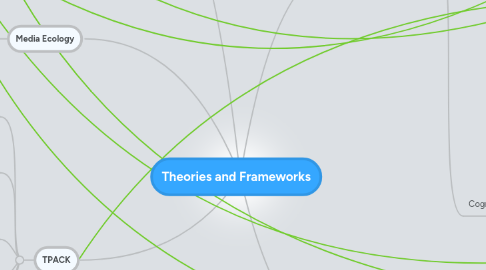
1. Media Ecology
1.1. Media infuse every act and action in society.
1.2. Media fix our perceptions and organize our experiences.
1.3. Media tie the world together.
1.4. Technology not only profoundly influences society, it also controls virtually all walks of life (opposite view of SCOT).
1.5. It is the media of a period that defines the essence of the society and there are four epochs: Tribal Era, Literate Era, Print Era and Electronic Era, which each correspond to the dominant mode of communication of the time respectively.
2. Technology Theories
2.1. SCOT
2.1.1. Social Construction of Technology
2.1.2. Technology does not determine human action, but that rather, human action shapes technology.
2.1.3. The ways a technology is used cannot be understood without understanding how that technology is embedded in its social context.
2.1.4. SCOT formalizes the steps and principles to follow when one wants to analyze the causes of technological failures or successes - it helps to decide whether a technology is useful or effective.
2.1.5. Each technological artifact has different meanings and interpretations for various groups.
2.1.6. The most basic relevant groups are the users and the producers of the technological artifact - including students and teachers.
3. TPACK
3.1. A framework to understand and describe the kinds of knowledge needed by a teacher for effective pedagogical practice in a technology enhanced learning environment.
3.2. Three kinds of knowledge
3.2.1. Technology
3.2.2. Content
3.2.3. Pedagogy
3.3. Teachers can facilitate learning in new and innovative ways that assure student learning and productivity.
3.4. Based on Schulman's PACK (Pedagogy and Content Knowledge), it is a theory matched to the digital age of education.
3.5. Teachers must stay aligned to TPACK in order to balance tech knowledge (TK), content knowledge (CK) and pedagogy knowledge (PK).
3.6. Also involves pedagogical content knowledge (PCK) - knowledge about how to combine pedagogy and content effectively, technological content knowledge (TCK) - knowledge about how technology may be used to provide new ways of teaching content, technological pedagogical knowledge (TPK) - the affordances and constraints of technology as an enabler of different teaching approaches, and technological pedagogical content knowledge (TPCK) - knowledge and understanding of the interplay between CK, PK and TK when using technology for teaching and learning.
3.7. Context is also important: Teachers are limited by what they are able to do within their own environment.
4. Learning Theories
4.1. Connectivism
4.1.1. Learning is a process of connecting specialized nodes or information sources.
4.1.2. Learning and knowledge rests in diversity of opinions.
4.1.3. Maintaining and nurturing connections is needed to facilitate continual learning.
4.1.4. Learning and knowledge rests in diversity of opinions.
4.1.5. Connectivism is a form of experiential learning which prioritizes the set of connections formed by actions and experience over the idea that knowledge is propositional.
4.1.6. The teacher provides assignments and activities but the students are responsible for the discovery of knowledge and the creation of connections
4.2. Constructivism
4.2.1. Learning is an active process in which the learner uses sensory input and constructs meaning out of it.
4.2.2. The crucial action of constructing meaning is mental: it happens in the mind.
4.2.3. Learning involves language: the language we use influences learning.
4.2.4. Learning is a social activity: our learning is intimately associated with our connection with other human beings, our teachers, our peers, our family, etc.
4.2.5. Learning is contextual: We do not learn isolated facts and theories. We learn in relationship to what else we know, what we believe, our prejudices, etc.
4.2.6. Teachers should pose problems of emerging relevance to students, and structure learning around primary concepts.
4.2.7. Student learning should be assessed in the context of teaching.
4.3. Cognitive Load
4.3.1. During complex learning activities the amount of information and interactions that must be processed simultaneously can either under-load, or overload the finite amount of working memory one possesses. All elements must be processed before meaningful learning can continue.
4.3.2. We want to reduce working memory load in order to facilitate the changes in long term memory associated with schema acquisition.
4.3.3. Information contained in instructional material must first be processed by working memory. For schema acquisition to occur, instruction should be designed to reduce working memory load.
4.3.4. People learn better when they can build on what they already understand (existing schemas), but the more a person has to learn in a shorter amount of time, the more difficult it is to process that information in working memory.
4.3.5. Instruction may be aimed at teaching learners problem solving skills, thinking and reasoning skills (including perception, memory, language, etc.).
